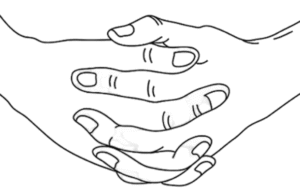Ushas Mudra
Introduction
Ushas Mudra, often referred to as the “Dawn Gesture,” is a yogic hand mudra designed to revitalize energy, enhance alertness, and stimulate mental clarity. This mudra is especially useful in the morning to awaken the body and mind, aligning with the symbolism of Ushas, the Vedic goddess of dawn.
The mudra is widely practiced in yoga therapy and meditation to harmonize pranic energy, improve vitality, and prepare the mind for focus and productivity.
Meaning
Ushas: Dawn, awakening, new beginning.
Mudra: Gesture used to direct prana (vital energy) and influence physiological and mental processes.
Overall Meaning:
Ushas Mudra symbolizes renewal, mental awakening, and energetic balance, supporting both physical vitality and mental clarity.
How to Perform / Practice
Sit comfortably in a meditative posture (Padmasana, Sukhasana, or on a chair) with a straight spine.
Clasp hands together and rest right thumb over the left thumb. Hold hands at abdomen.
Close your eyes, breathe slowly and evenly, and visualize fresh energy and morning sunlight filling your body.
Practice for 15–30 minutes daily, or 5–10 minutes in short intervals.
Tip: Best practiced early in the morning for an energetic start to the day.
Benefits
Physical Benefits:
Stimulates energy and combats morning fatigue.
Improves circulation and oxygenation throughout the body.
Supports metabolism and overall vitality.
Mental & Emotional Benefits:
Enhances alertness, focus, and mental clarity.
Reduces lethargy and mental dullness.
Encourages positivity and emotional balance.
Energetic / Spiritual Benefits:
Activates upward flow of prana for mental and spiritual awakening.
Harmonizes body and mind energies.
Supports meditation and mindfulness practices.
Contraindications
Avoid if experiencing hand, finger, or joint injuries.
Not recommended for individuals with severe arthritis or chronic finger pain.
Discontinue if numbness, tingling, or discomfort occurs.
Anatomy & Physiology
Muscles: Engages intrinsic hand muscles (lumbricals, interossei) to maintain finger positions.
Joints: Flexion at ring and little fingers; extension at index and middle fingers.
Nervous System: Stimulates parasympathetic system while enhancing alertness.
Circulation: Improves microcirculation in hands and fingers; indirectly stimulates systemic energy flow.
Kinesiology
Improves fine motor control and finger dexterity.
Enhances neuromuscular coordination between hand and brain.
Supports static postural stability during seated meditation or pranayama practice.
Neurology
Stimulates brain regions associated with alertness, focus, and energy regulation.
Balances sympathetic and parasympathetic activity to reduce fatigue while promoting vitality.
Supports neural plasticity, improving mental clarity, attention, and cognitive function.
Duration of Practice
Daily Practice: 15–30 minutes, can be split into 2–3 sessions.
Short Practice: 5–10 minutes during morning routines or meditation sessions.
Can be combined with pranayama, meditation, or other mudras for enhanced effect.
Counter Mudra
If excessive energy or restlessness develops, switch to Gyan Mudra or Chala Mudra to balance energy.
Gentle hand stretching or shaking is recommended after long practice.
Conclusion
Ushas Mudra is a simple yet powerful hand gesture to revitalize energy, enhance mental clarity, and awaken the mind and body. Regular practice harmonizes physical, mental, and energetic systems, making it an ideal tool for morning meditation, yoga therapy, and daily wellness. Proper execution ensures maximum benefits without discomfort.
FAQ
Q1: Can beginners practice Ushas Mudra?
A: Yes, it is safe and simple; start with 5–10 minutes and gradually increase.
Q2: Can it help with morning fatigue?
A: Yes, it stimulates energy and alertness, providing a revitalized start to the day.
Q3: Can it be combined with other mudras?
A: Yes, often combined with Dhyana Mudra, Prana Mudra, or Gyan Mudra.
Q4: Is it suitable for meditation?
A: Yes, it enhances alertness and energy, supporting effective meditation practice.
References
Swami Satyananda Saraswati, Mudras for Healing and Transformation.
Iyengar, B.K.S., Light on Yoga.
Saraswati, S., Pranayama and Mudras in Yoga Therapy.
Fishman, L., Yoga for Emotional Balance.
Journal of Bodywork and Movement Therapies, 2018; 22(4): Effects of Hand Mudras on Mental and Physiological Functions.
